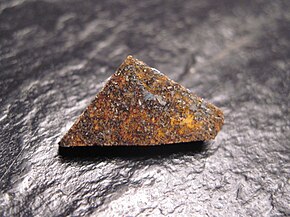User:Tobias1984/Sandbox 7
| Primitive enstatite achondrite | |
|---|---|
| — Group — | |
 Zakłodzie is one of the meteorites that is often described as a primitive enstatite achondrite. | |
| Compositional type | Stony and Stony-Iron |
| Type | Differentiated |
| Class | Primitive Achondrite |
| Composition | Enstatite (60-? %) |
| Petrologic type | 6 to 7 |
| Total known specimens | Around 12 (ongoing scientific debate) |
Primitive enstatite achondrite is a proposed meteorite group, that would be part of the primitive achondrites. It would accompany some meteorites that are currently classified as enstatite chondrites and enstatite achondrites. The group is defined as the residue of the partial melting of an enstatite chondrite. Similar to the primitive achondrites some of the members of this group have signs of partial melting and relic chondrules.[1]
Description[edit]
Examples[edit]
A number of meteorites have been described as primitive enstatite achondrites. They all share... QUE 94204 and Itqiy are currently classified as enstatite chondrites with petrologic type 7 (EH7).
QUE 94204[edit]
Queen Alexandra Range 94204 is a stony meteorite that consists of enstatite (orthoenstatite), plagioclase, meteoric iron (kamacite) and troilite. Accessory minerals include daubréelite and cristobalite. It is coarse grained, has no chondrules, and shows no signs of brecciation. It is currently classified as an enstatite chondrite with petrologic type 7 (EH7).[2]
Petrologic type 7 indicates that the meteorite experienced temperatures close to the melting point within the parent body. Although complete melting can be discounted, some scientists believe that the meteorite experienced partial melting. Some inclusions indicate that two types of melt (or magma) formed: one with a iron-nickel-sulfide composition and one with a plagioclase±pyroxene composition. This episode of partial melting would indicate that QUE 94204 is a primitive enstatite achondrite.[3]
The only other enstatite chondrite with petrologic type 7 is the Itqiy meteorite.
Zakłodzie[edit]
Zakłodzie meteorite is a stony-iron meteorite composed of enstatite (Orthoenstatite) (60 %), meteoric iron (20 %), troilite (10 %) and feldspar (10 %). Accessory minerals include alabandite, amphibole, oldhamite, keilite, schreibersite.[4] It is currently classified as an enstatite-rich achondrite that is ungrouped.[5]
The primitive character of Zakłodzie is emphasized by relic chondrules which also occur in many of the meteorites of the primitive achondrites. Another line of evidence is the occurrence of keilite, an iron-magnesium sulfide mineral with the formula (Fe,Mg)S, that is interpreted to form through impact-melting and subsequent fast cooling ( quenching).[6] All of these observations are interpreted as indicators for partial melting, which could happen during a impact event that triggered melting.[7][8]
NWA 2526[edit]
Northwest Africa 2526
NWA 4301[edit]
Northwest Africa 4301
Itqiy[edit]
List[edit]
The following meteorites are described as products of partial melting:
| Name | Current Classification | Descbribed as |
|---|---|---|
| Happy Canyon | Enstatite chondrite, (EL6/EL7).[9] | |
| Ilafegh 009 | Enstatite chondrite, (EL7).[10] | |
| Itqiy | Enstatite chondrite, (EH7).[11] | Partial-melt.[7] |
| NWA 1235 | Aubrite, anomalous.[12] | Impact-melt-breccia.[7] |
| NWA 2526 | Enstatite achondrite, ungrouped.[13] | |
| NWA 2788 | Primitive achondrite, ungrouped.[14] | |
| NWA 4301 | Enstatite achondrite, ungrouped.[15] | Impact-melt-breccia.[7] |
| QUE 94204 | Enstatite chondrite, (EH7).[2] | Impact-melt rock.[7] |
| QUE 97289 | Aubrite, anomalous.[16] | Impact-melt rock.[7] |
| QUE 97348 | Aubrite, anomalous.[17] | Impact-melt rock.[7] |
| Yamato 8404 | Enstatite chondrite, (EH6).[18] | |
| Yamato 82189 | Enstatite chondrite, EH group, impact melted.[19] | |
| Yamato 793225 | Enstatite chondrite, EH6, anomalous.[20] | |
| Zakłodzie | Enstatite achondrite, ungrouped.[5] | Impact-melt-breccia.[7] |
References[edit]
- ^ PILSKI, Andrzej S. (2011). "Primitive Enstatite Achondrites" (PDF). Meteorites. Retrieved 13 January 2013.
{{cite journal}}: Unknown parameter|coauthors=ignored (|author=suggested) (help) - ^ a b "Queen Alexandra Range 94204". Meteoritical Society.
- ^ Izawa, M. R. M. (2011). "A Primitive enstatite achondrite produced by partial melting of an E-chondrite-like protolith" (PDF). 42nd Lunar and Planetary Science Conference. Retrieved 12 January 2013.
{{cite journal}}: Unknown parameter|coauthors=ignored (|author=suggested) (help) - ^ Grossman, J. N. (2000). "The Meteoritical Bulletin". Meteoritics & Planetary Science. 35: A199–A225. doi:10.1111/j.1945-5100.2000.tb01797.x.
- ^ a b "Zakłodzie". Meteoritical Society. Retrieved 21 December 2012.
- ^ Keil, Klaus (30 April 2007). "Occurrence and origin of keilite, (Fe>0.5,Mg<0.5)S, in enstatite chondrite impact-melt rocks and impact-melt breccias". Chemie der Erde - Geochemistry. 67 (1): 37–54. doi:10.1016/j.chemer.2006.05.002.
- ^ a b c d e f g h Keil, Klaus (31 December 2009). "Enstatite achondrite meteorites (aubrites) and the histories of their asteroidal parent bodies". Chemie der Erde - Geochemistry. 70 (4): 295–317. doi:10.1016/j.chemer.2010.02.002.
- ^ Przylibski, Tadeusz A. (2005). "The Zaklodzie enstatite meteorite: Mineralogy, petrology, origin, and classification". Meteoritics & Planetary Science. 40: A185–A200. doi:10.1111/j.1945-5100.2005.tb00424.x.
{{cite journal}}: Unknown parameter|coauthors=ignored (|author=suggested) (help) - ^ "Happy Canyon". Meteoritical Society. Retrieved 13 January 2013.
- ^ "Ilafegh 009". Meteoritical Society. Retrieved 13 January 2013.
- ^ "Itqiy". Meteoritical Society. Retrieved 13 January 2013.
- ^ "Northwest Africa 1235". Meteoritical Society. Retrieved 13 January 2013.
- ^ "Northwest Africa 2526". Meteoritical Society. Retrieved 13 January 2013.
- ^ "Northwest Africa 2788". Meteoritical Society. Retrieved 13 January 2013.
- ^ "Northwest Africa 4301". Meteoritical Society. Retrieved 13 January 2013.
- ^ "Queen Alexandra Range 97289". Meteoritical Society. Retrieved 13 January 2013.
- ^ "Queen Alexandra Range 97348". Meteoritical Society. Retrieved 13 January 2013.
- ^ "Yamato 8404". Meteoritical Society. Retrieved 13 January 2013.
- ^ "Yamato 82189". Meteoritical Society. Retrieved 13 January 2013.
- ^ "Yamato 793225". Retrieved 13 January 2013.
